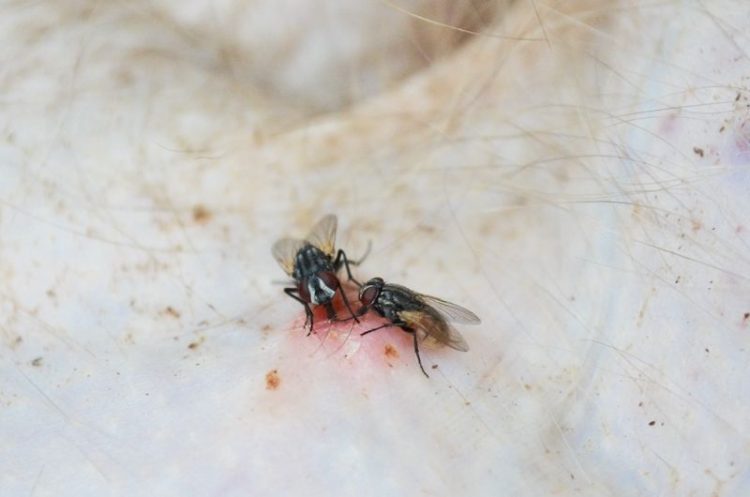Flies as a mechanical vector for yaws

Two flies sucking lesion exudate on a skin ulcer from a Treponema pallidum infected olive baboon (Papio anubis) at Lake Manyara National Park in Tanzania. Photo: F. Paciencia
Lesions on arms and legs, deformed faces – yaws is a tropical disease that infects the skin, bones and cartilage. It is caused by the bacterium Treponema pallidum subspecies pertenue. Mostly children in remote tropical areas of Africa, Southeast Asia and the Pacific are infected.
Until recently it was assumed that the disease is only spread by direct skin contact with an infected person. An international research group led by Sascha Knauf from the German Primate Center – Leibniz Institute for Primate Research now published a study that suggests flies as mechanical vectors for the bacterium. The finding is of importance for currently ongoing yaws eradication campaigns (EBioMedicine 2016).
Where the roads end and only scattered villages interrupt the jungle, the area of yaws begins. In its primary stage, yaws infection causes skin lesions and if untreated progresses into severe bone and joint deformations of the extremities and face. Infection is transmitted from person-to-person by direct contact with contagious lesions. The World Health Organization (WHO) assumes that 75 to 80 per cent of the patients are under 15 years old.
Theoretically, one pill of an antibiotic would be enough to prevent children from suffering and to cure the disease that is caused by the bacterium Treponema pallidum subspecies pertenue. In practice however, there are many villages that do not have access to modern medicine. The WHO, for the second time, tries to eradicate yaws finally by 2020.
However, as studies by Sascha Knauf and colleagues suggest, there could be major challenges involved. The scientists have not only isolated an identical bacterium in monkeys suggesting that there is a nonhuman reservoir, they now also discovered the pathogen on flies. “The human-to-human as well as possible monkey-to-human transmission becomes a complete new dimension”, says Sascha Knauf from the German Primate Center.
Sascha Knauf and colleagues investigated 207 flies originating from two national parks in Tanzania. In both parks skin ulcerations caused by Treponema are common in wild baboons. In about 20 per cent of the wild-caught flies Treponema-DNA was found. “Our results support the possibility that flies play a role in yaws transmission”, says Sascha Knauf, first author of the publication.
The scientists want to continue their research on the topic, because it is not yet clear, whether the bacteria found in the flies are viable. “If we can confirm that the flies transmit viable bacteria and that infected monkeys act as a nonhuman reservoir, there will always be cases of yaws even if the disease is apparently eradicated due to medicine and hygienic measures”, says Knauf.
Original publication
Sascha Knauf, Jane Raphael, Oriol Mitjà, Inyasi A. V. Lejora, Idrissa S. Chuma, Emmanuel K. Batamuzi, Julius D. Keyyu, Robert Fyumagwa, Simone Lüert, Charmie Godornes, Hsi Liu, Christiane Schwarz, David Smajs, Philippe Grange, Dietmar Zinner, Christian Roos, Sheila A. Lukehart (2016): Isolation of Treponema DNA from necrophagous flies in a natural ecosystem. EBioMedicine, doi: 10.1016/j.ebiom.2016.07.033, http://www.ebiomedicine.com/article/S2352-3964(16)30343-7/fulltext
Contact and notes for editors
Dr. Sascha Knauf
Tel.: +49 551 3851-259, E-mail: sknauf@dpz.eu
Dr. Susanne Diederich (Communication)
Tel.: +49 551 3851-359, E-mail: sdiederich@dpz.eu
The German Primate Center (DPZ) – Leibniz Institute for Primate Research conducts biological and biomedical research on and with primates in the fields of infection research, neuroscience and primate biology. In addition, it operates four field stations in the tropics and is a reference and service center for all aspects of primate research. The DPZ is one of the 88 research and infrastructure institutes of the Leibniz Association in Germany.
http://www.dpz.eu/en/home/single-view/news/fliegen-als-krankheitsuebertraeger.ht…
Media Contact
All latest news from the category: Life Sciences and Chemistry
Articles and reports from the Life Sciences and chemistry area deal with applied and basic research into modern biology, chemistry and human medicine.
Valuable information can be found on a range of life sciences fields including bacteriology, biochemistry, bionics, bioinformatics, biophysics, biotechnology, genetics, geobotany, human biology, marine biology, microbiology, molecular biology, cellular biology, zoology, bioinorganic chemistry, microchemistry and environmental chemistry.
Newest articles

Compact LCOS Microdisplay with Fast CMOS Backplane
…for High-Speed Light Modulation. Researchers from the Fraunhofer Institute for Photonic Microsystems IPMS, in collaboration with HOLOEYE Photonics AG, have developed a compact LCOS microdisplay with high refresh rates that…

New perspectives for material detection
CRC MARIE enters third funding period: A major success for terahertz research: Scientists at the University of Duisburg-Essen and the Ruhr University Bochum have been researching mobile material detection since…

CD Laboratory at TU Graz Researches New Semiconductor Materials
Using energy- and resource-saving methods, a research team at the Institute of Inorganic Chemistry at TU Graz aims to produce high-quality doped silicon layers for the electronics and solar industries….



